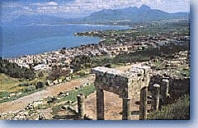|
Located 17 kilometers east of Palermo overlooking the coast
just outside Santa Flavia, Solunto is situated on the slopes of Mount Catalfamo, not far from Bagheria. (It's easy to reach from the Santa
Flavia train station.) This town was built on the site of a Phoenician
village called Kfra founded around 700 BC but expanded by the Greeks, who
conquered it in 396 BC. By 254 BC, during the First Punic War, it had
fallen into Roman hands, and most of the construction visible at Solunto
is distinctly Roman. During the 3rd century AD, the town was abandoned for
reasons unknown to us. The ruins of Solunto were rediscovered in the
sixteenth century and excavations have continued since then.
The Greek city was built on a grid plan. The Romans enlarged the wide main street they called decumanus, referred to today as the "Via dell'Agora," the Greek "agora" referring to a marketplace or other large square. Solunto has no complete structures; all that remains of most of the buildings here are floors and the lower portions of some walls and columns. However, a few of the dwellings and public buildings are well enough preserved to provide us with a tangible idea of their construction and purpose. Portions of a few mosaics and paintings are still visible, and the peristyle of one of the houses suggests its former grandeur. There is even a small odeum (theatre) and a meeting chamber.
From Palermo, Solunto is more conveniently reached than Tindari, though the latter is better preserved in certain respects. Solunto is interesting for being essentially Roman in character, with little visible evidence of its Phoenician or Greek origins. Though Palermo itself has visible traces of Roman architecture (most notably in Piazza Vittoria and near the Church of San Cataldo) and some Phoenician foundations (such as those under the Royal Palace and in the Cassaro district), most of these are not nearly as evident as the paved streets and other features that await you at Solunto, which also offers a nice view of the sea. A hike up to the wooded area near the summit above Solunto will reward you with a more impressive view of the entire Gulf of Palermo. Solunto has an archaeological museum (Antiquarium), but the larger one in Palermo houses some of the more noteworthy finds from the site. |

